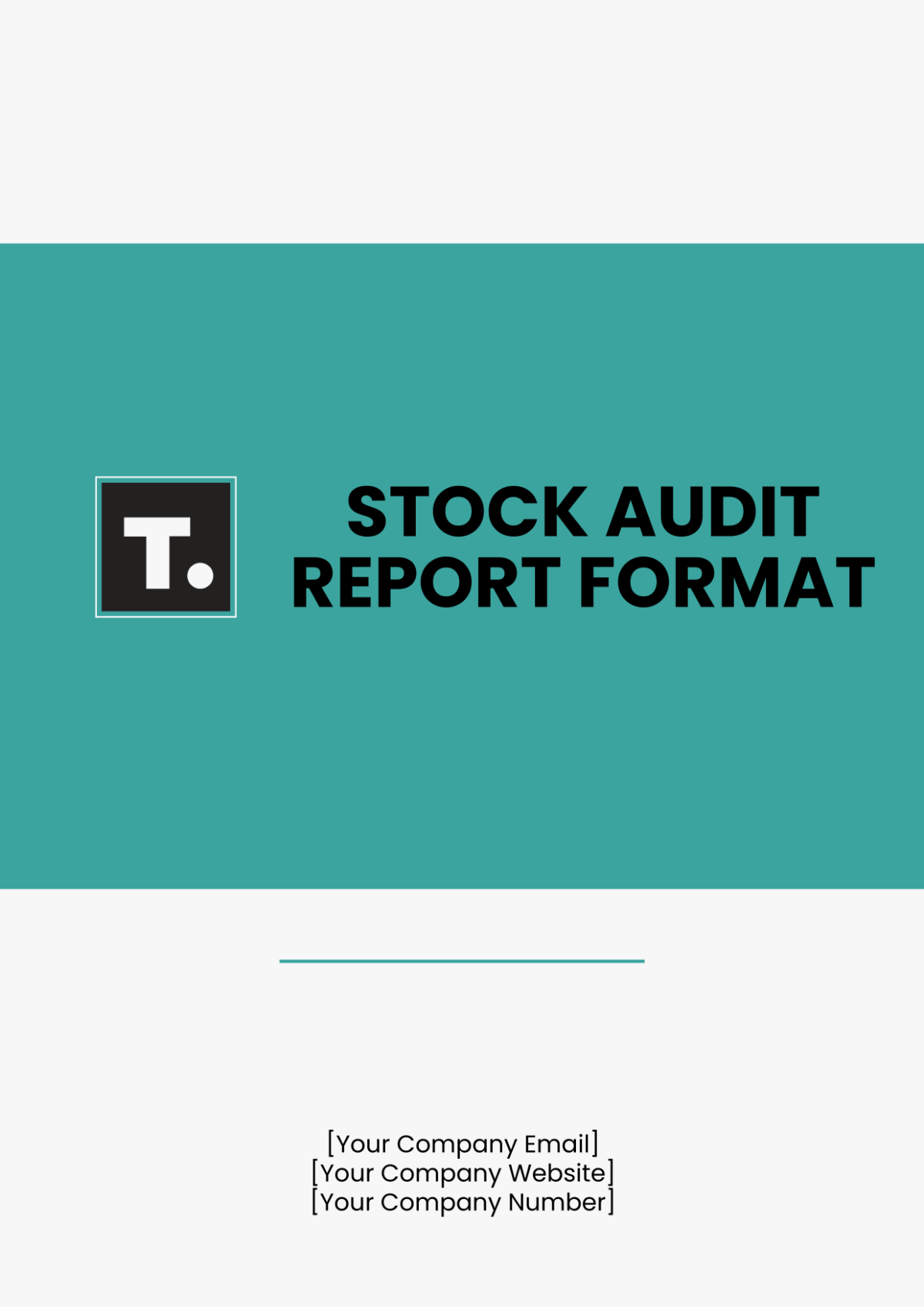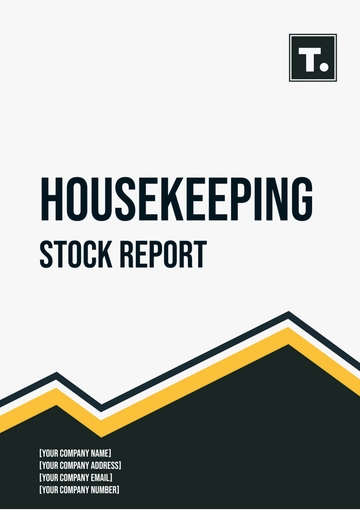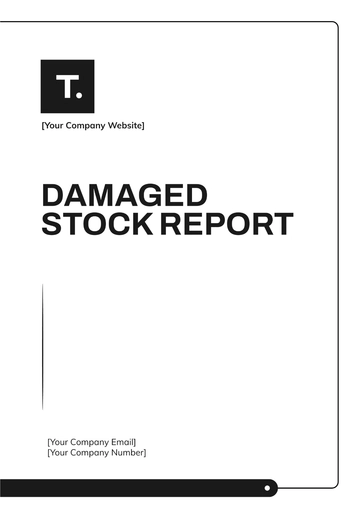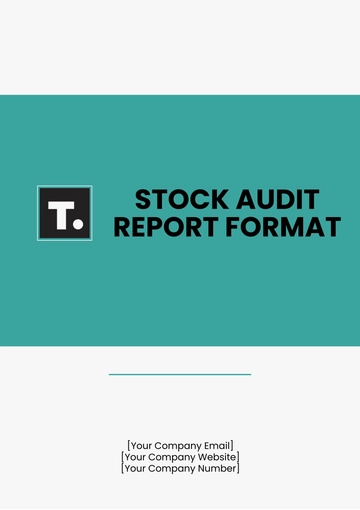Free Stock Audit Report Format

Prepared By: [YOUR NAME]
Date: [DATE]
Company Name | [YOUR COMPANY NAME] |
Name | [YOUR NAME] |
[YOUR EMAIL] | |
Phone Number | [YOUR COMPANY NUMBER] |
Address | [YOUR COMPANY ADDRESS] |
Website | [YOUR COMPANY WEBSITE] |
I. Executive Summary
This Stock Audit Report conducted on [DATE] aims to facilitate decision-making related to inventory management, such as adjustments to ordering processes, stock replenishment strategies, or warehouse operations. It provides a concise overview of the purpose and goals of the audit, setting the stage for the detailed analysis that follows.
II. Introduction
The purpose of this audit is to evaluate the effectiveness of current inventory management practices at [YOUR COMPANY NAME] and provide recommendations to enhance operational efficiency and accuracy. It outlines the primary objective of the audit, which is to assess the current state of inventory management within the company and identify areas for improvement.
III. Scope of Audit
The audit covers the following areas:
Inventory Records Accuracy: This involves assessing the accuracy of the physical inventory records compared to the recorded figures in the system. It aims to ensure that there are no discrepancies between the actual stock levels and the recorded data.
Stock Levels: This entails evaluating the stock levels concerning minimum and maximum requirements set by the company. It helps in identifying any excess or shortage of inventory and ensures optimal stocking levels.
Obsolete and Slow-moving Stock: This involves identifying any outdated or slow-moving stock that may be taking up valuable warehouse space and tying up capital. It helps in developing strategies to clear out such inventory and prevent future accumulation.
Warehouse Operations: This examines the efficiency of stock handling processes within the warehouse, including stock replenishment, storage layout, and overall workflow. It aims to identify any inefficiencies or bottlenecks in warehouse operations.
IV. Methodology
The audit was conducted using the following methods:
Physical Stock Count: This involved physically counting the inventory items in the warehouse to cross-check against the inventory records. It ensures the accuracy of stock levels and helps in identifying any discrepancies.
Inventory Management System Analysis: This entailed reviewing the inventory management system for data accuracy and integrity. It ensures that the system accurately reflects the actual stock levels and transactions.
Stakeholder Interviews: This involved gathering insights from warehouse staff and management regarding inventory management practices and challenges. It provides valuable input from those directly involved in warehouse operations.
V. Key Findings
Inventory Records Accuracy: The physical stock count was [PERCENTAGE]% accurate compared to recorded figures. This indicates a high level of accuracy in inventory management practices.
Stock Levels: [PERCENTAGE]% of items were above the maximum stock level, while [PERCENTAGE]% were below the minimum required level. This highlights the need for better stock level management to prevent overstocking or stock outs.
Obsolete and Slow-moving Stock: Identified [PERCENTAGE]% of the total inventory as obsolete or slow-moving. This underscores the importance of regularly reviewing and clearing out outdated inventory to free up warehouse space and capital.
Warehouse Operations: Identified inefficiencies in the stock replenishment process and storage layout. This indicates areas where improvements can be made to streamline warehouse operations and enhance efficiency.
VI. Recommendations
Based on the findings, the following recommendations are made:
Improve Inventory Records: Implement routine checks to enhance accuracy. This may involve regular physical audits or system checks to ensure that inventory records are up to date and accurate.
Review Stock Levels: Adjust ordering processes to maintain optimal stock levels. This may include setting more accurate minimum and maximum stock levels based on demand forecasts and sales trends.
Dispose of Obsolete Stock: Develop a plan to clear obsolete and slow-moving stock. This may involve discounting or liquidating outdated inventory to free up space and capital for more profitable items.
Enhance Warehouse Operations: Optimize the storage layout and streamline the stock replenishment process. This may include reorganizing the warehouse layout for better space utilization and implementing automated stock replenishment systems to improve efficiency.
VII. Conclusion
The Stock Audit revealed key areas for improvement in [YOUR COMPANY NAME]'s inventory management practices. By addressing the identified shortcomings, the company can achieve more efficient and effective operations. This section summarizes the main findings of the audit and emphasizes the importance of implementing the recommendations to drive positive change and improvement in inventory management practices.
- 100% Customizable, free editor
- Access 1 Million+ Templates, photo’s & graphics
- Download or share as a template
- Click and replace photos, graphics, text, backgrounds
- Resize, crop, AI write & more
- Access advanced editor
Effortlessly manage your inventory with Template.net's Stock Audit Report Format Template. Fully customizable and editable, this template ensures precision and adaptability. Easily tailor it to your needs using our AI Editor Tool for a seamless and professional stock audit report every time.
You may also like
- Sales Report
- Daily Report
- Project Report
- Business Report
- Weekly Report
- Incident Report
- Annual Report
- Report Layout
- Report Design
- Progress Report
- Marketing Report
- Company Report
- Monthly Report
- Audit Report
- Status Report
- School Report
- Reports Hr
- Management Report
- Project Status Report
- Handover Report
- Health And Safety Report
- Restaurant Report
- Construction Report
- Research Report
- Evaluation Report
- Investigation Report
- Employee Report
- Advertising Report
- Weekly Status Report
- Project Management Report
- Finance Report
- Service Report
- Technical Report
- Meeting Report
- Quarterly Report
- Inspection Report
- Medical Report
- Test Report
- Summary Report
- Inventory Report
- Valuation Report
- Operations Report
- Payroll Report
- Training Report
- Job Report
- Case Report
- Performance Report
- Board Report
- Internal Audit Report
- Student Report
- Monthly Management Report
- Small Business Report
- Accident Report
- Call Center Report
- Activity Report
- IT and Software Report
- Internship Report
- Visit Report
- Product Report
- Book Report
- Property Report
- Recruitment Report
- University Report
- Event Report
- SEO Report
- Conference Report
- Narrative Report
- Nursing Home Report
- Preschool Report
- Call Report
- Customer Report
- Employee Incident Report
- Accomplishment Report
- Social Media Report
- Work From Home Report
- Security Report
- Damage Report
- Quality Report
- Internal Report
- Nurse Report
- Real Estate Report
- Hotel Report
- Equipment Report
- Credit Report
- Field Report
- Non Profit Report
- Maintenance Report
- News Report
- Survey Report
- Executive Report
- Law Firm Report
- Advertising Agency Report
- Interior Design Report
- Travel Agency Report
- Stock Report
- Salon Report
- Bug Report
- Workplace Report
- Action Report
- Investor Report
- Cleaning Services Report
- Consulting Report
- Freelancer Report
- Site Visit Report
- Trip Report
- Classroom Observation Report
- Vehicle Report
- Final Report
- Software Report















